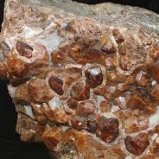
Grossular (also known as grossularite), like other garnets, forms rounded crystals with 12 rhombic or 24 trapezoidal faces or combinations of these and some other forms. This crystal habit is classic for the garnet minerals. Grossular is the calcium aluminum garnet and forms in contact or regional metamorphic enviroments as does andradite the calcium iron garnet. It is believed that these garnets form from the metamorphism of impure siliceous limestones. Grossular has many color possibilities and is probably the most colorful of the garnets. The orange variety is the most common and specimens of orange grossular crusts are prized by many collectors. The green garnets from the Thetford Mines in Quebec, Canada are now considered by many to be uvarovite, or at least a grossular-uvarovite hybrid, whereas the Jeffrey Mine and others are mostly grossular with a chromium-induced tint, "chrome grossular". Hessonite is a red variety of grossular and is also sometimes used as a gem.
There are many interesting beliefs and mystic stories recorded about garnets. Garnet may even protect one from thieves. Normally garnets were exchanged between friends to ensure that they would meet again and to symbolize their affection. Garnets were supposed to hold healing properties, relieving skin conditions, protecting against poisons, and if placed under the pillow, garnet would protect one from bad dreams. Magical properties were assigned in the 13th century when garnet was used in rituals. It was suspose to repel insects and some five hundred years ago, people believed that it would drive away demons.
Pronunciation: GROSS•you•lar GAR•net (accent on capitalized syllable)
Appearance: Cinnamon orange (hessonite), pink and emerald green (tsavorite garnet).
Luster: vitreous
Diaphaneity: translucent; may appear opaque in hand specimen
Hardness: 6.5-7.5
Specific gravity: 3.5-4.3
Cleavage/fracture: none (glassy fracture)
Occurrence Sri Lanka, Canada, Pakistan, South Africa, Tanzania, Russia and the U.S.. This is a fairly rare garnet.
Other distinguishing properties: Forms in 12x-sided equant balls. Commonly found in metamorphic rocks, such as garnet shists. Garnets are commonly used as abrasives and in sand paper, because of their hardness.
Uses: abrasive, mineral specimens and as a Gemstone
Grossalar increases our receptivity to the images held in Nature — sky, clouds, sun rays, moonbeams, and the green and growing things of Earth. This stone liberates the human spirit via its soothing, grounding and calming effect on the emotional body.